Citizenship Soviet Union Name Yakov Zel'dovich | Role Physicist Fields Physics | |
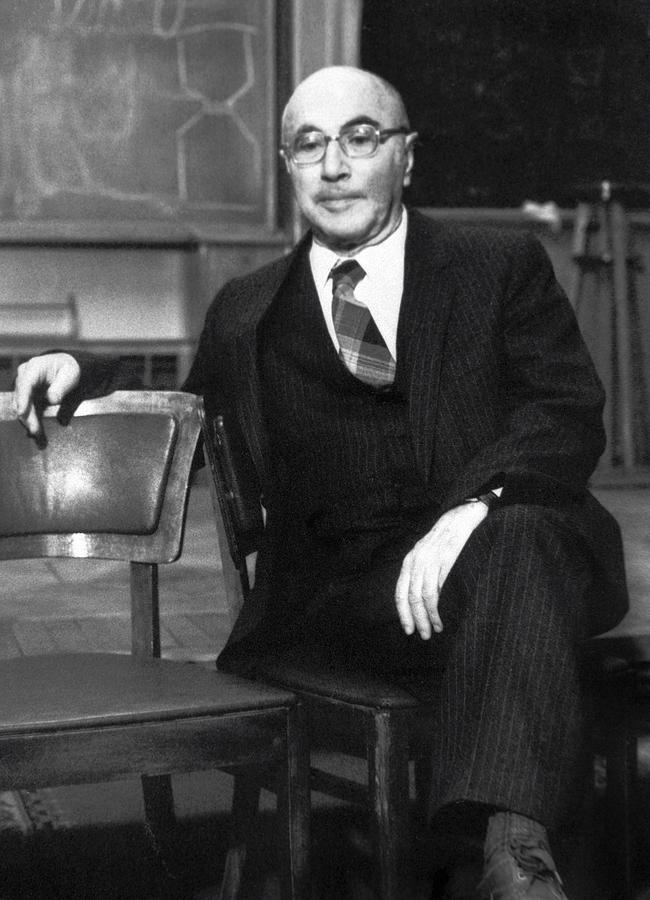 | ||
Institutions Institute of Chemical Physics
Moscow State University
Sternberg Astronomical Institute Alma mater Saint Petersburg State University Notable students Roman Juszkiewicz
Igor Dmitriyevich Novikov
Sergei Kopeikin
Sergei Shandarin
Alexei Starobinsky Known for Soviet atomic bomb project
Zel'dovich Mechanism
Theory of Nuclear Chain Reactions
Astrophysics and Cosmology Notable awards Order of the October Revolution (1962)
Orders of the Red Banner
Dirac Medal (1985) Died December 2, 1987, Moscow, Russia Education Saint Petersburg State University Awards Order of the Red Banner Books The Almighty Chance, Selected Works of Yakov Bo, Relativistic Astrophysics - 2: The Str, Quantum Mechanics: Selected, My Universe: Selected Similar People Igor Dmitriyevich Novikov, Grigory Barenblatt, Isaak Yaglom, Sergei Kopeikin | ||
Yakov Borisovich Zel'dovich (Belarusian: Якаў Барысавіч Зяльдовіч, Russian: Я́ков Бори́сович Зельдо́вич; 8 March 1914 – 2 December 1987), also known as YaB, was a Russian physicist of Belarusian Jewish ethnicity, who is known for his prolific contributions in cosmology and the physics of thermonuclear and hydrodynamical phenomena.
Contents
- Early life and education
- Soviet atomic bomb program
- Academia and Cosmology
- Black hole thermodynamics
- Awards and honors
- References
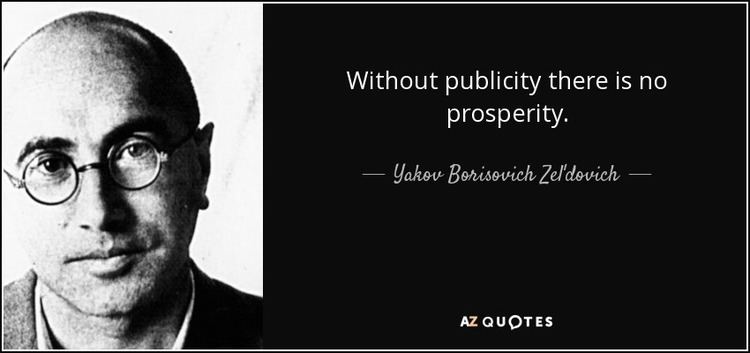
In addition, he also played a wider and crucial role in the development of the Soviet Union's nuclear bomb project, associated closely in nuclear weapons testing to study the effects of nuclear explosion from 1943 until returning to academia in 1963 to embark towards pioneering contributions on the fundamental understanding of the thermodynamics of black holes and expanding the study scope of cosmology.
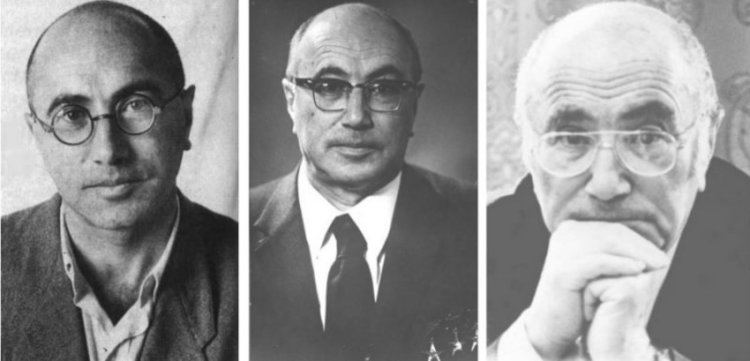
Early life and education
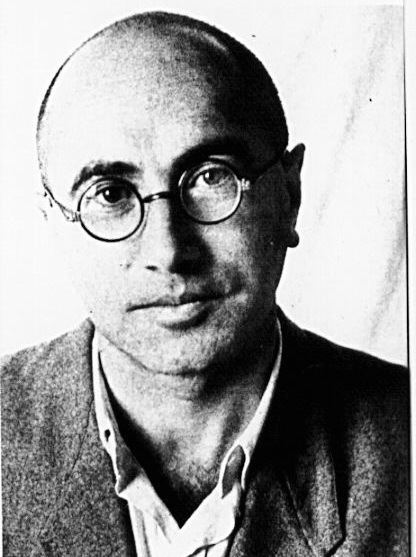
Yakov Zel'dovich was born into an ethnic Belarussian Jewish family in his grandfather's house in Minsk, Belarusian region in Russia, on 8 March 1914. But in mid of 1941, the Zel'dovich family moved to Petrograd (now St. Petersburg) and resided until August 1941 when the family was evacuated together with the faculty of the Institute of Chemical Physics to Kazan to avoid the Axis Invasion of the Soviet Union. They remained in Kazan until the summer of 1943, when Zel'dovich moved to Moscow.
His father, Boris Naumanovich Zel'dovish, a lawyer; his mother, Anna Petronova Zel'dovich (née. Kiveliovich), a translator from French to Russian, was a member of Writer's Union. Despite being born into a devoted and religious Jewish family, Zel'dovich was an "absolute atheist."
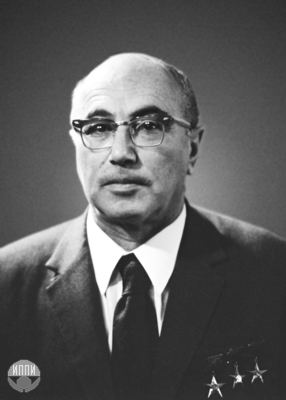
Zel'dovich was an autodidact and did not earn a college degree or even attend college, but was regarded as a remarkably versatile intellect during his life explored and made major contributions to a wide range of scientific endeavors. From a given opportunity in May 1931, he secured an appointment as a laboratory assistant at the Institute of Chemical Physics of the USSR Academy of Sciences, and remained associated with the institute for the remainder of his life. As a laboratory assistant, he received preliminary instructions on the topics involved in the physical chemistry and built up his reputation among his seniors at the Institute of Chemical Physics. Without having earned an undergraduate degree, he was allowed to attend the post graduate coursework at the Saint Petersburg State University due to upheavals took place in educational infrastructure in Russia.
In 1936, he was successful in his candidacy for the Candidate of Science degree (a Soviet equivalent of PhD), having successfully defended his dissertation on the topic of the "adsorption and catalysis on heterogeneous surfaces." Centrality of his thesis focused towards the research on the Freundlich (or classical) adsorption isotherm, and Zel'dovich discovered the theoretical foundation of this empirical observation.
From 1932–34, Zel'dovich attended the undergraduate courses on physics and mathematics at the Leningrad State University (now St. Petersburg University), and later attended the technical lectures on introductory physics at the Leningrad Polytechnic Institute (now Peter the Great St. Petersburg Polytechnic University).
In 1939, Zel'dovich prepared his dissertation based on the mathematical theory of the physical interpretation of the nitrogen oxidation, and successfully received the Doctor of Science on Physmatics when it was reviewed by one its reviewer, Aleksandr A. Freiman. Zel'dovich discovered its mechanism, known in physical chemistry as Thermal NO Mechanism or Zel'dovich Mechanism.
Soviet atomic bomb program
Zel'dovich is regarded as one of the secret principles involved in the Soviet Union's nuclear weapons project, and his travel abroad were highly restricted to the Eastern Europe under close security by the Soviet Union. Soon after the discovery of nuclear fission by German chemist Otto Hahn in 1939, Russian physicists began investigating the spectrum of physics of fission and began hosting the seminars on that topic, extending the invitation to Igor Kurchatov and Yulii Khariton in 1940.
In May 1941, he closely worked with Yulii Khariton in achieving the constructed theory on theory of the kinetics of nuclear reactions in the presence of the critical conditions. The work of Khariton and Zel'dovich was extended towards the theories of ignition, combustion and detonation, that accounted for features not previously explained or correctly predicted features that had not yet been observed. The modern theory of detonation accordingly is called ZND theory (Zel'dovich-von Neumann-Dohring), and engaged the tedious work on fast neutron calculations but the work had delayed due to the German invasion of Soviet Union that disrupted the findings which were marked as classified in June 1941. In 1942, Zel'dovich was relocated to Kazan where he was tasked by the People's Commissariat of Munitions to carry out the work on the conventional gun powders to be supplied to the Soviet Army while Khariton was asked to design the new types of conventional weaponry.
In 1943, Joseph Stalin decided to launch the arms build-up of nuclear weapons, having given the charge to Igor Kurchatov who requested Stalin to relocate Zel'dovich and Khariton to Moscow for nuclear weapons program. Zel'dovich joined Igor Kurchatov's small team at the secretive laboratory in Moscow to launch the work on the nuclear combustion theory and became a head of the theoretical department at the Arzamas-16 in 1946.
He developed a scientific report with Isaak Gurevich, Isaak Pomeranchuk, and Khariton on the feasibility of releasing energy through nuclear fusion triggered by an atomic explosion and presented it to Igor Kurchatov. Zel'dovich was extremely beneficial of physical and technical knowledge provided by German physicist Klaus Fuchs and American physicist Theodore Hall, working on American Manhattan Project to develop nuclear weapons.
In 1949, he led a team of physicists that conducted the first nuclear test, the RDS-1, based roughly on the American design obtained through the atomic spies in the United States, though he continued his fundamental work on explosive theory. Zel'dovich then began working on modernizing the successive designs of the nuclear weapon and initially conceived the idea of hydrogen bomb to Andrei Sakharov and others. In the course of his work on nuclear weapons, Zel'dovich did ground-breaking work in radiation hydrodynamics, and the physics of matter at high pressure.
In 1950–53, Zel'dovich computed calculations necessary for the feasibility of the hydrogen bomb that were verified by Andrei Sakharov, although the two groups worked in parallel on the development of the thermonuclear fusion. However, it was Sakharov that radically changed the approach to thermonuclear fusion, aided by Vitaly Ginzburg in 1952. He remained associated with the nuclear testings while heading the experimental laboratories at Arzamas-16 until October 1963, when he left for the academia.
Academia and Cosmology
In 1952 he began work in the field of elementary particles and their transformations. He predicted the beta decay of a pi meson. Together with S. Gershtein he noticed the analogy between the weak and electromagnetic interactions, and in 1960 predicted the muon catalysis (more precisely, the muon-catalysed dt-fusion) phenomenon. In 1977 Zel'dovich together with Fyodor Shapiro was awarded the Kurchatov Medal, the highest award in nuclear physics of the USSR. The citation was "for prediction of characteristics of ultracold neutrons, their detection and investigation". He was elected academician of the USSR Academy of Sciences on 20 June 1958. He was a head of division at the Institute of the Applied Mathematics of the USSR Academy of Sciences from 1965 until January 1983.
In early 1960s he started working in astrophysics and physical cosmology. In 1964, he and independently Edwin Salpeter were the first to suggest that accretion discs around massive black holes are responsible for the huge amounts of energy radiated by quasars. Since 1965 he was also a professor at the Department of Physics of the Moscow State University, and a head of the division of Relativistic Astrophysics at the Sternberg Astronomical Institute.
Zel'dovich worked on the theory of the evolution of the hot universe, the properties of the microwave background radiation, the large-scale structure of the universe, and the theory of black holes. He predicted, with Rashid Sunyaev, that the cosmic microwave background should undergo inverse Compton scattering. This is called the Sunyaev-Zel'dovich effect, and measurements by telescopes such as the Atacama Cosmology Telescope and the South Pole Telescope has established it as one of the key observational probes of cluster cosmology. Zel'dovich contributed sharp insights into the nature of the large scale structure of the universe, in particular, through the use of Lagrangian perturbation theory (the Zel'dovich approximation) and the application of the Burgers' equation approach via the adhesion approximation.
Black hole thermodynamics
Zel'dovich played a key role in developing the theory of black hole evaporation due to Hawking radiation, where in his visit to Moscow in 1973, Soviet scientists Zel'dovich and Alexei Starobinsky showed Stephen Hawking that, according to the quantum mechanical uncertainty principle, rotating black holes should create and emit particles.
Awards and honors
Igor Kurchatov called him a "genius" and Andrei Sakharov named him "a man of universal scientific interests." Stephen W. Hawking once said to Zel'dovich: "before I met you, I believed you to be a 'collective author', like Bourbaki."
